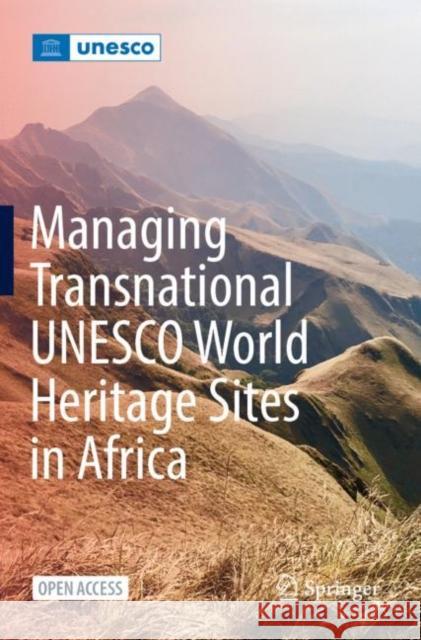Managing Transnational UNESCO World Heritage Sites in Africa » książka



Managing Transnational UNESCO World Heritage Sites in Africa
ISBN-13: 9783030809126 / Angielski / Miękka / 2023 / 190 str.
Managing Transnational UNESCO World Heritage Sites in Africa
ISBN-13: 9783030809126 / Angielski / Miękka / 2023 / 190 str.
(netto: 145,82 VAT: 5%)
Najniższa cena z 30 dni: 153,11 zł
ok. 20 dni roboczych.
Darmowa dostawa!
Part 1: Eastern Africa.- Chapter 1. Defending Peace between Ethiopia and Eritrea through Shared Cultural Heritage: Opportunities from Aksum, Sacred Landscapes of Tigray and Qoahito Cultural Landscape (Alula Tesfay Asfha).- Chapter 2. Managing the migration - Masai Mara National Reserve and Serengeti WHS connectivity (Jacinta Nzioka).- Chapter 3. Challenges in Preparing a Serial Transnational Nomination for Geometric Rock Art sites in Lake Victoria region of Kenya, Tanzania and Uganda (Jackline Nyiracyiza Besigye).- Part 2: Southern Africa. Chapter 4. Transboundary Cooperation for effective management of the Okavango Delta World Heritage site - the case of the Cubango-Okavango River Basin (Gertrude Matswiri).- Chapter 5. Management and Conservation of the Mosi-Oa-Tunya/Victoria Falls World Heritage Property (John Zulu).- Chapter 6. Engaging local communities in conservation and governance of the World Heritage in a transboundary context: an example from the Maloti Drakensberg Park World Heritage Site (Lesotho/South Africa) (Joyce Loza).- Part 3: Central Africa. Chapter 7. The Transboundary Management Regime of the Virunga Conservation Area across the Congolese, Rwandese and Ugandan Borders: Challenges and Opportunities (Birabi Allan Kenneth).- Chapter 8. Lake Chad Cultural Landscape: An Uncommon Transboundary potential in the midst of multiple challenges (Houehounha Dodé).- Chapter 9. The Sangha Tri-National : An Example of Cross-Border Biodiversity Management in Central Africa (Achile Mengamenya Goué.- Chapter 10. Developing a Sustainable Transboundary Collaboration in Post-Armed Conflict Areas of DRC, Rwanda and Uganda (Musoke Deogratias).- Chapter 11. Regional cooperation for the conservation of biodiversity in the Congo Basin forests: feedback on actions carried out in the TRIDOM-TNS landscapes (Tales Carvalho Resende).- Part 4: Western Africa. Chapter 12. From the inscription to the extension of Koutammakou, the Land of the Batammariba, World Heritage site - an example of successful transboundary cooperation between Benin and Togo for the preservation of the site (Barry Alyssa).- Chapter 13. Extension of Sukur Cultural Landscape in Nigeria to Incorporate the 16 DGB sites on the Wandala Cultural Landscape in Cameroon as a Serial-Transboundary World Heritage site (Anthony Sham).- Part 5: General. Chapter 14. Trans-Boundary Cooperation for Effective Management of World Heritage Sites in Africa (Arinze Madeleine Ogechukwu).
Dodé Houehounha is a Protected Areas specialist with almost 10 years of experience in governance and management of protected and conserved areas in Africa. He currently works at the Africa Unit of the World Heritage Centre as Associate Programme Officer. He has managed several projects and programmes, which promote the safeguarding of natural World Heritage sites as a driver for sustainable development. He holds a MBA in Leadership and International Business, a Forestry Engineer Diploma in Natural Resources Management and a Master degree in Protected Areas Management. He has authored and co-authored several scientific publications on conservation of natural resources.
Edmond Moukala is the Head of Office and Representative of UNESCO in Mali. He has a master's degree in law and a degree in civil engineering. He has worked for UNESCO for more than 25 years, 16 of which in Asia. He specialises in the fields of heritage preservation, sustainable tourism, capacity building of local populations and dialogue of civilisations. He undertakes research in the areas of diplomatic relations between Africa and China, Africa and its development potential, comparative study of the case for Chinese economic development and its added value for African development. He is the editor and co-editor of several publications, including one on heritage conservation and sustainable development.
This open access book focuses on the management of transboundary UNESCO World Heritage sites in the Africa region. It highlights the region as a model of best practices on cross-border collaboration in view of enforcing the conservation of the site, engaging with local communities, and fighting against (in some cases) extremist groups inhabiting these sites. It also addresses the role of the World Heritage Convention in promoting transboundary cooperation and offers both an analysis and a list of priorities for improving the effective management of transboundary properties in sub-Saharan Africa defined.
This book presents chapters from experts, site managers, technical and financial partners, academics, and representatives of the private sector from 20 African countries and 15 institutions involved in African heritage management. It provides an opportunity to share current and planned initiatives at the transboundary sites inscribed on the UNESCO World Heritage List, including the Maloti-Drakensberg Park (South Africa, Lesotho), W-Arly-Pendjari Complex (Benin, Burkina Faso, Niger), Sangha Trinational (Cameroon, Congo, Central African Republic), and Mosi-oa-Tunya / Victoria Falls (Zambia, Zimbabwe). The publication further discusses African sites that could eventually be proposed for extension or nomination to the UNESCO World Heritage List in collaboration with the local and indigenous communities. This book is suitable for heritage specialists and readers interested in cross-border collaborations.
1997-2024 DolnySlask.com Agencja Internetowa
KrainaKsiazek.PL - Księgarnia Internetowa









